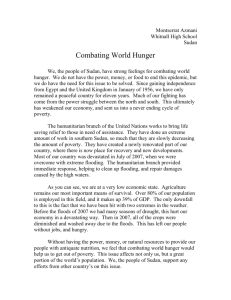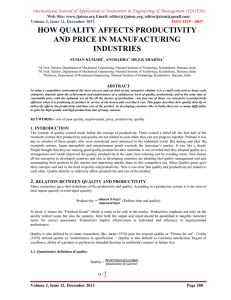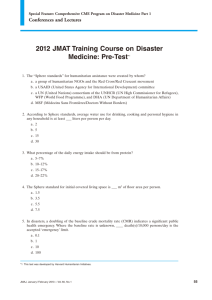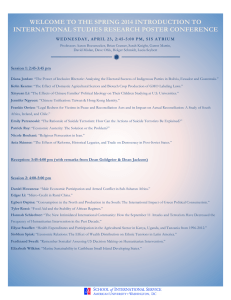Assessment of (HeRAMS) Knowledge Management System of Humanitarian Emergency inSudan
advertisement
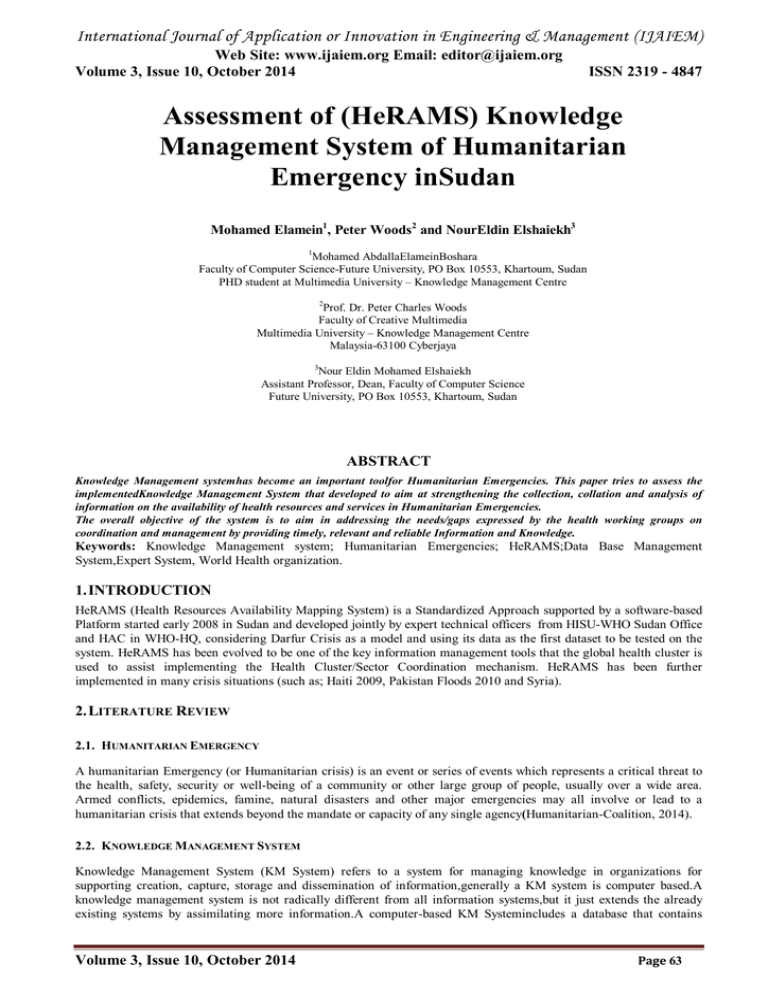
International Journal of Application or Innovation in Engineering & Management (IJAIEM) Web Site: www.ijaiem.org Email: editor@ijaiem.org Volume 3, Issue 10, October 2014 ISSN 2319 - 4847 Assessment of (HeRAMS) Knowledge Management System of Humanitarian Emergency inSudan Mohamed Elamein1, Peter Woods2 and NourEldin Elshaiekh3 1 Mohamed AbdallaElameinBoshara Faculty of Computer Science-Future University, PO Box 10553, Khartoum, Sudan PHD student at Multimedia University – Knowledge Management Centre 2 Prof. Dr. Peter Charles Woods Faculty of Creative Multimedia Multimedia University – Knowledge Management Centre Malaysia-63100 Cyberjaya 3 Nour Eldin Mohamed Elshaiekh Assistant Professor, Dean, Faculty of Computer Science Future University, PO Box 10553, Khartoum, Sudan ABSTRACT Knowledge Management systemhas become an important toolfor Humanitarian Emergencies. This paper tries to assess the implementedKnowledge Management System that developed to aim at strengthening the collection, collation and analysis of information on the availability of health resources and services in Humanitarian Emergencies. The overall objective of the system is to aim in addressing the needs/gaps expressed by the health working groups on coordination and management by providing timely, relevant and reliable Information and Knowledge. Keywords: Knowledge Management system; Humanitarian Emergencies; HeRAMS;Data Base Management System,Expert System, World Health organization. 1. INTRODUCTION HeRAMS (Health Resources Availability Mapping System) is a Standardized Approach supported by a software-based Platform started early 2008 in Sudan and developed jointly by expert technical officers from HISU-WHO Sudan Office and HAC in WHO-HQ, considering Darfur Crisis as a model and using its data as the first dataset to be tested on the system. HeRAMS has been evolved to be one of the key information management tools that the global health cluster is used to assist implementing the Health Cluster/Sector Coordination mechanism. HeRAMS has been further implemented in many crisis situations (such as; Haiti 2009, Pakistan Floods 2010 and Syria). 2. LITERATURE REVIEW 2.1. HUMANITARIAN EMERGENCY A humanitarian Emergency (or Humanitarian crisis) is an event or series of events which represents a critical threat to the health, safety, security or well-being of a community or other large group of people, usually over a wide area. Armed conflicts, epidemics, famine, natural disasters and other major emergencies may all involve or lead to a humanitarian crisis that extends beyond the mandate or capacity of any single agency(Humanitarian-Coalition, 2014). 2.2. KNOWLEDGE MANAGEMENT SYSTEM Knowledge Management System (KM System) refers to a system for managing knowledge in organizations for supporting creation, capture, storage and dissemination of information,generally a KM system is computer based.A knowledge management system is not radically different from all information systems,but it just extends the already existing systems by assimilating more information.A computer-based KM Systemincludes a database that contains Volume 3, Issue 10, October 2014 Page 63 International Journal of Application or Innovation in Engineering & Management (IJAIEM) Web Site: www.ijaiem.org Email: editor@ijaiem.org Volume 3, Issue 10, October 2014 ISSN 2319 - 4847 knowledge items and an activity record that is associated with the knowledge items. (Murphy, 2006), stated that KM Systems are vital for disaster detection, response planning, andmanagement. These systems aid in early warning, and provide decision support for disaster response and recovery management. 2.3. KNOWLEDGE-BASED SYSTEM A Knowledge-based system (KBS): is a computer program that reasons and uses a knowledge base to solve complex problems. The term is broad and is used to refer to many different kinds of systems. The onecommon theme that unites all knowledge based systems is an attempt to represent knowledge explicitly via tools such as ontologies and rules rather than implicitly via code the way a conventional computer program does. A knowledge based system has two types of sub-systems: a knowledge base and an inference engine. The knowledge base represents facts about the world. The inference engine represents logical assertions and conditions about the world(Reid , 1985). The first knowledgebased systems were ruled based expert systems. One of the most famous was Mycin a program for medical diagnosis. These early expert systems represented facts about the world as simple assertions in a flat database and used rules to reason about and as a result add to these assertions. Representing knowledge explicitly via rules had several advantages: Acquisition & Maintenance. Using rules meant that domain experts could often define and maintain the rules themselves rather than via a programmer. Explanation. Representing knowledge explicitly allowed systems to reason about how they came to a conclusion and use this information to explain results to users. For example, to follow the chain of inferences that led to a diagnosis and uses these facts to explain the diagnosis. Reasoning. Decoupling the knowledge from the processing of that knowledge enabled general purpose inference engines to be developed. These systems could develop conclusions that followed from a data set that the initial developers may not have even been aware of.(Hayes-Roth, Waterman, & Lenat, 1983) As knowledge-based systems became more complex the techniques used to represent the knowledge base became more sophisticated. Rather than representing facts as assertions about data, the knowledge-based became more structured, representing information using similar techniques to object-oriented programming such as hierarchies of classes and subclasses, relations between classes, and behavior of objects. As the knowledge base became more structured reasoning could occur both by independent rules and by interactions within the knowledge base itself. For example, procedures stored as demons on objects could fire and could replicate the chaining behavior of rules.(Mettrey, 1987) 2.4. THE ROLE OF KNOWLEDGE-BASED SYSTEM IN EMERGENCY MANAGEMENT Information and knowledge have become important issues in health as medical practice requires tools to extend the mind's limited capacity and to recall and process large numbers of relevant variables. Information and knowledge management (IKM) enable and sustain informed decision-making for managing disaster risk, and are essential for coordinated action. Informed decision-making needs a sound information and knowledge base as well as dedicated and skilled professionals(UNISDR, 2013). Based on experiences through different Emergencies we can assume that one of the main problems is the lack of an exact and efficient identification system through which the victims, especially all those under the debris can be identified. Type of knowledge related to the disastrous situation and the relevant technology to handle the knowledge, which can speed up the search, rescue, relief, and as a whole Disaster Management process are highly important 2.5. HEALTH RESOURCES AVAILABILITY AND MAPPING SYSTEM IN SUDAN Not being able to obtain a comprehensive understanding of available health resources over an affected area, nor the ability to track the evolution of these services over time, were the major issues that led to the development of HeRAMS.HeRAMS was developed in order to enhance situational awareness within the health sector response to the ongoing emergency in the Darfur states. 2.5.1. SYSTEM COMPONENTS The components of the system are standard Excel sheet (HeRAMS Matrix) that is already built up with many standard predefined lists and validation rules to minimize data entry errors and ensure consistency, this used as an input for the central database system. The outputs of the system werestatistics, analytical reports and Maps; this reportwas built based on standard formulas defined by expert technical officers. Volume 3, Issue 10, October 2014 Page 64 International Journal of Application or Innovation in Engineering & Management (IJAIEM) Web Site: www.ijaiem.org Email: editor@ijaiem.org Volume 3, Issue 10, October 2014 ISSN 2319 - 4847 Input Standard Data Gathering Matrix Output HeRAMS Database System Statistical, analytical Reports and Maps Figure 1: HeRAMS Components 2.5.2. TYPES OF DATA COLLECTED BY HERAMS Comprehensive set of health resources and servicesdata collected at HF level; data includes: Geographical data Type and Functionality of the HF Inpatient capacity Water sources & electricity Management of the HF (i.e., health partners ) Human resources (HF based & Community based staff) Health Services provided by each HF (categorized by community care, PHC, and SHC Levels ) 2.5.3. DATA Q UALITY ASSURANCE Many validity checks were performed to ensure consistency and reliability of the data: i. Implementing the data collection sheet with standard pre-defined lists for the data types of known parameters; (i.e. ., standard locations list, HF Types (…,Validation rules for entered data types ii. Upon importing data from the data collection sheet to the Database system, other validation rules are performed to ensure consistency of data types iii. Performing local quality control check; coordinated editing and auditing processPeer reviewing of the collected raw data; conducted by the data gathering team (field PHC officers) and developers , Appraising &reviewing of generated reports before dissemination. Other procedures were applied to ensure quality data: I. Collecting data by personally interviewing partners and direct field mission, rather than sending partners a copy of the data collection sheet to be filled II. Developing data dictionary for clear definition of data elements; “use of meta-data“ III. Unifying the reporting channel & maintaining one source of data to avoid duplication of reporting IV. Providing hands-on training for the system users (i.e., PHC officers); up-to-date V. Establishing a mechanism for frequent feedback to those collecting and using data 2.5.4. HERAMS AIMS AND OBJECTIVES HeRAMS was developed to provide the decision makers with timely, relevant, and reliable information about the available health resources, in order to support them: Knowledge base for Emergency. Sustainable data collection mechanism for reliable and timely information management Support of decision making to initiate planning Volume 3, Issue 10, October 2014 Page 65 International Journal of Application or Innovation in Engineering & Management (IJAIEM) Web Site: www.ijaiem.org Email: editor@ijaiem.org Volume 3, Issue 10, October 2014 ISSN 2319 - 4847 Prioritizing actions , allocating resources and monitoring changes Methodology sharing tools. Measuring gaps and Resources planning Ensuring evidence-based actions Enhancing coordination & accountability Helping Health cluster in developing exit scenario Monitoring Who is doing What Where, and when 2.5.5. DATA COLLECTION, REPORTING CHANNEL, QUALITY ASSURANCE MECHANISM, AND SYSTEM PRODUCTS: Figure 2: Data collection, reporting channel, derived from(WHO, Sudan office) 2.5.6. LIMITATION AND COMMON MISTAKES As perreviewingof reports that generated from the tool and by the comments of the health cluster committee(WHOSudan, 2013) below are some points that could be as limitation: i. Some of the HFs managing partners don’t reflect the support of other partners; this is why some partners are inquiring about their present. ii. Verification of the data must be initially performed at state level; and cross checking by partner PHC coordinator and WHO PHC officer. iii. Not all states provide data such as (Catchment Population, No. of Consultations, No. of Referred cases, and total no. of Antenatal Visits) which has number nature. iv. Missing of the GIS coordinate. Volume 3, Issue 10, October 2014 Page 66 International Journal of Application or Innovation in Engineering & Management (IJAIEM) Web Site: www.ijaiem.org Email: editor@ijaiem.org Volume 3, Issue 10, October 2014 ISSN 2319 - 4847 2.6. CONCLUSION HeRAMS has been initiated and developed between February and December 2008 in the three States of Darfur, Sudan, to assess and monitor the availability of health sector resources provided by both the international and local response to the humanitarian crisis Based on this experience, HeRAMS evolved as a generic tool of the Global Health Cluster to be used in the roll out of the health clusters in the countries implementing the cluster approach, in order to assist Health Cluster Coordinators and partners in assessing and monitoring the availability of resources and services provided to populations affected by the humanitarian crisis. HeRAMS as KMStool played a valuable role in achieving disaster management objectives, by leveraging existing knowledge, converting new knowledge into action and aid in early warning. Managing HeRAMS informationfor reuse affecting expedite the process of emergency response and recoverymanagement REFERENCES [1] Hayes-Roth, F., Waterman, D., & Lenat, D. (1983). Building Expert Systems. Addison-Wesley. [2] Humanitarian-Coalition. (2014). Retrieved from http://humanitariancoalition.ca/: http://humanitariancoalition.ca/info-portal/factsheets/what-is-a-humanitarian-crisis [3] Mettrey, W. (1987). An Assessment of Tools for Building Large Knowledge- BasedSystems. AI Magazine. [4] Murphy, T. a. (2006). Knowledge Management, Emergency Response, and Hurricane Katrina, International Journal of Intelligent Control Systems,. [5] Organization, W. H. (n.d.). HeRAMS Users Guide. Retrieved from www.who.int/hac/: www.who.int/hac/ [6] Reid , S. (1985). Knowledge-Based Systems Concepts, Techniques, Examples. Schlumberger-Doll Research. [7] UNISDR. (2013). Information and Knowledge Management for Disaster Risk Reduction (IKM4DRR) Framework and Scorecard. [8] WHO-Sudan. (2013). Health Resources Availability Mapping System (HeRAMS). [9] Zhang, D. &. (2002). A Knowledge Management Framework for the Support of Decision Making in Humanitarian Assistance/Disaster Relief. AUTHOR Mohamed AbdallaElamein:received the B.Sdegree in computer Science from Computer Man College in 2001 and M.S. degree in computer Science and information from Gezira University in 2010. During 20012005, he worked in Computer Man College, as cooperative teacher and software Developer. He is now with World Health Organization working as Data Manager supporting Sudan office for more than 8 years Volume 3, Issue 10, October 2014 Page 67

